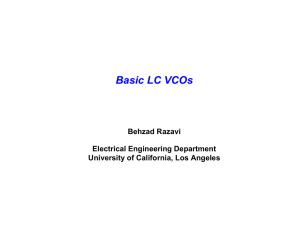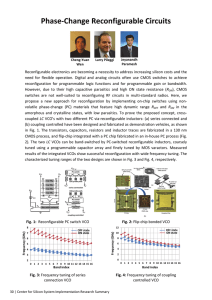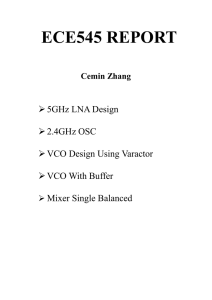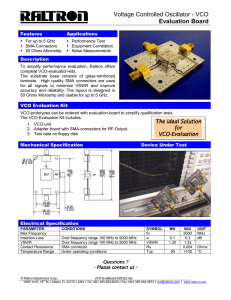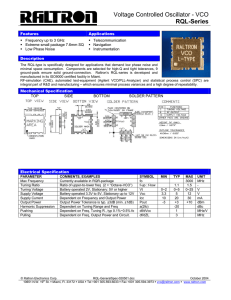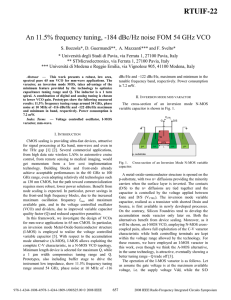A HIGH FIGURE-OF-MERIT LOW PHASE NOISE 15
advertisement
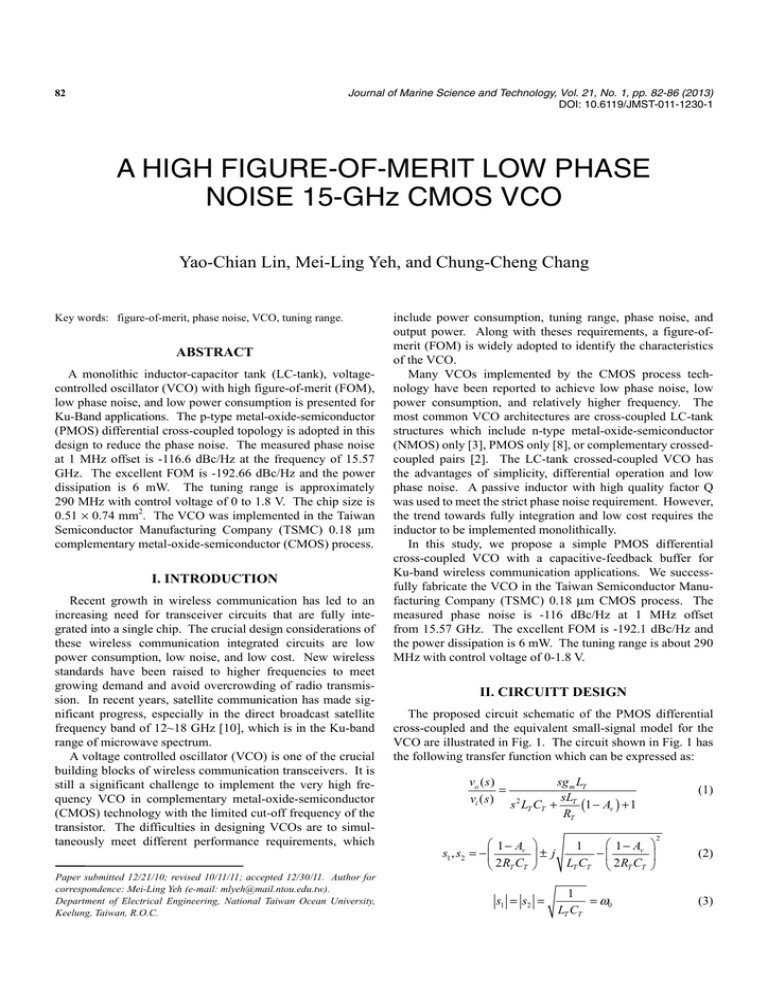
Journal of Marine Science and Technology, Vol. 21, No. 1, pp. 82-86 (2013)
DOI: 10.6119/JMST-011-1230-1
82
A HIGH FIGURE-OF-MERIT LOW PHASE
NOISE 15-GHz CMOS VCO
Yao-Chian Lin, Mei-Ling Yeh, and Chung-Cheng Chang
Key words: figure-of-merit, phase noise, VCO, tuning range.
ABSTRACT
A monolithic inductor-capacitor tank (LC-tank), voltagecontrolled oscillator (VCO) with high figure-of-merit (FOM),
low phase noise, and low power consumption is presented for
Ku-Band applications. The p-type metal-oxide-semiconductor
(PMOS) differential cross-coupled topology is adopted in this
design to reduce the phase noise. The measured phase noise
at 1 MHz offset is -116.6 dBc/Hz at the frequency of 15.57
GHz. The excellent FOM is -192.66 dBc/Hz and the power
dissipation is 6 mW. The tuning range is approximately
290 MHz with control voltage of 0 to 1.8 V. The chip size is
0.51 × 0.74 mm2. The VCO was implemented in the Taiwan
Semiconductor Manufacturing Company (TSMC) 0.18 µm
complementary metal-oxide-semiconductor (CMOS) process.
I. INTRODUCTION
Recent growth in wireless communication has led to an
increasing need for transceiver circuits that are fully integrated into a single chip. The crucial design considerations of
these wireless communication integrated circuits are low
power consumption, low noise, and low cost. New wireless
standards have been raised to higher frequencies to meet
growing demand and avoid overcrowding of radio transmission. In recent years, satellite communication has made significant progress, especially in the direct broadcast satellite
frequency band of 12~18 GHz [10], which is in the Ku-band
range of microwave spectrum.
A voltage controlled oscillator (VCO) is one of the crucial
building blocks of wireless communication transceivers. It is
still a significant challenge to implement the very high frequency VCO in complementary metal-oxide-semiconductor
(CMOS) technology with the limited cut-off frequency of the
transistor. The difficulties in designing VCOs are to simultaneously meet different performance requirements, which
Paper submitted 12/21/10; revised 10/11/11; accepted 12/30/11. Author for
correspondence: Mei-Ling Yeh (e-mail: mlyeh@mail.ntou.edu.tw).
Department of Electrical Engineering, National Taiwan Ocean University,
Keelung, Taiwan, R.O.C.
include power consumption, tuning range, phase noise, and
output power. Along with theses requirements, a figure-ofmerit (FOM) is widely adopted to identify the characteristics
of the VCO.
Many VCOs implemented by the CMOS process technology have been reported to achieve low phase noise, low
power consumption, and relatively higher frequency. The
most common VCO architectures are cross-coupled LC-tank
structures which include n-type metal-oxide-semiconductor
(NMOS) only [3], PMOS only [8], or complementary crossedcoupled pairs [2]. The LC-tank crossed-coupled VCO has
the advantages of simplicity, differential operation and low
phase noise. A passive inductor with high quality factor Q
was used to meet the strict phase noise requirement. However,
the trend towards fully integration and low cost requires the
inductor to be implemented monolithically.
In this study, we propose a simple PMOS differential
cross-coupled VCO with a capacitive-feedback buffer for
Ku-band wireless communication applications. We successfully fabricate the VCO in the Taiwan Semiconductor Manufacturing Company (TSMC) 0.18 µm CMOS process. The
measured phase noise is -116 dBc/Hz at 1 MHz offset
from 15.57 GHz. The excellent FOM is -192.1 dBc/Hz and
the power dissipation is 6 mW. The tuning range is about 290
MHz with control voltage of 0-1.8 V.
II. CIRCUITT DESIGN
The proposed circuit schematic of the PMOS differential
cross-coupled and the equivalent small-signal model for the
VCO are illustrated in Fig. 1. The circuit shown in Fig. 1 has
the following transfer function which can be expressed as:
vo ( s )
sg m LT
=
vi ( s ) s 2 L C + sLT 1 − A + 1
( v)
T T
RT
1 − Av
s1 , s2 = −
2 RT CT
1 − Av
1
−
± j
LT CT 2 RT CT
s1 = s2 =
1
= ω0
LT CT
(1)
2
(2)
(3)
Y.-C. Lin et al.: A High Figure-of-Merit Low Phase Noise 15-GHz CMOS VCO
VDD
83
600
400
Ct
Vo+
Ct
200
0
-200
-400
M1
C1
out +, mV
out -, mV
L1
vtune
M2
C2
Vo-
-600
33.48
33.50
33.46
33.48
33.50
out +, mV
out -, mV
LT
200
150
100
50
0
-50
-100
-150
-200
33.42
33.40
33.38
33.36
33.34
33.32
33.30
Ct
33.46
Rp
33.44
ro
gmVi
33.44
Vo
Ci
33.42
(a)
Vi
33.40
time, nsec
(a)
M4
M3
33.38
33.36
33.34
33.32
33.30
L2
L2
time, nsec
(b)
(b)
Fig. 2. Simulation of C1 and C2 (a) with capacitive feedback and (b)
without capacitive feedback.
14.2
1.4
14.0
1.3
13.8
1.2
13.6
1.1
Inductance (nH)
where LT = (L1/2)//L2, RT = ro//Rp, CT = Csg + Cdg + Ct, and
Av = gmRT. The circuit is designed using the Advanced Design
System (ADS) and Momentum Electromagnetic (EM) simulator. The circuit is constructed using only PMOS transistors,
due to the lower flicker noise of PMOS transistors as compared to NMOS transistors [5]. L1 replaces the traditional
transistor current source in order to increase the voltage swing.
L2 and Ct form the main resonator to obtain the oscillation
frequency and tuning range. M1 and M2 are crossed-coupled
pairs that provide negative resistance to compensate for the
parasitic impedance of inductors and capacitors. The transistor sizes of M1 and M2 are 45 µm and 0.18 µm, respectively.
Transistors (M3 and M4) and capacitors (C1 and C2) are the
buffer. C1 and C2 form the capacitive feedback to improve the
phase noise and linearity. C1 and C2 forming the capacitive
feedback are designed to improve the output swing performance which is shown in Fig. 2. From the figure, we can obtain
that with capacitive feedback structure, the output swing is
increased.
The on-chip inductor plays an important role in the characteristics of VCO. Improving the Q-factors of the inductors
can reduce phase noise and power consumption. In order to
gain the center frequency in the Ku-band range, we simulate
Q-factor
Fig. 1. (a) The schematic of the proposed VCO and (b) the equivalent
small-signal model.
13.4
1.0
12.0 12.5 13.0 13.5 14.0 14.5 15.0 15.5 16.0 16.5 17.0 17.5 18.0
Frequency (GHz)
Fig. 3. Simulated quality factor and inductance versus frequency of L1.
the inductance and Q-factor of L1 from 12 GHz to 18 GHz. L1
is symmetrical with the center tapped inductor. Fig. 3 illustrates the characteristics of inductance and quality factor Q
versus frequency. At an approximate frequency of around
15.5 GHz, the quality factor of L1 is 14.09 and the inductance
value is 1.21 nH. We use a standard inductor for L2. Fig. 4
illustrates the simulated inductance and quality factor versus
frequency characteristics of L2. The inductance of L2 is 234.1
pH and the quality factor is 19.62 at 15.5 GHz.
A key component in the design of VCO is a varactor, used
Journal of Marine Science and Technology, Vol. 21, No. 1 (2013)
235.0
20.0
234.8
19.5
234.6
234.4
19.0
234.2
350
300
C_Varactor (fF)
20.5
Inductance (pH)
Q-factor
84
18.5
234.0
18.0
12.0 12.5 13.0 13.5 14.0 14.5 15.0 15.5 16.0 16.5 17.0 17.5 18.0
Frequency (GHz)
100
0.0 0.2 0.4 0.6 0.8 1.0 1.2 1.4 1.6 1.8
Tuning Voltage (V)
(a)
15
G
B
14
MOS_var (Q-factor)
n+
200
150
Fig. 4. Simulated quality factor and inductance versus frequency of L2.
B
250
n+
n-well
13
12
11
10
9
8
p-epi
7
12.0 12.5 13.0 13.5 14.0 14.5 15.0 15.5 16.0 16.5 17.0 17.5 18.0
Fig. 5. Cross section of a MOS varactor.
Frequency (GHz)
(b)
Fig. 7. (a) Simulated Ct capacitance versus tuning control voltage, and
(b) quality factor of Ct versus frequency.
Cpar
Gate
Lg
Za
Lsd
Rsd
Rg
Cg
Bulk
Dnwpsub
Csub
Rsub
Fig. 6. Equivalent circuit model of the varactor.
to determine the performance of the tuning range. We used
the accumulation-mode MOS varactor in our design, as it has
better performance than an inversion-mode MOS varactor and
diode varactor [1]. The cross section of the accumulation-mode MOS varactor is illustrated in Fig. 5. The varactor
has two terminals: G and B. The variable capacitance is
controlled by the gate voltage. The equivalent model of
varactor is illustrated in Fig. 6 [11]. The impedance Za is
defined as (neglecting Cpar)
Z a = Rg +
1
+ jω Lg
jω Cg
(4)
Lg is the ploy gate and vias parasitic inductance. Cg is the
variable capacitance of the MOS varactor. Rg is the gate
and channel parasitic resistance. Cpar is the parasitic capacitance of the MOS varactor. Dnwpsub is the diode between
N-well and P-substrate. Rsub and Csub are P-substrate resistance and P-substrate capacitance. Rsd is the parasitic resistance connected to the bulk. Lsd is the bulk and vias parasitic
inductance.
Capacitance and quality factor are, respectively, obtained
from the following equations:
Cg =
1
ω 2 Lg − ω I m ( Z a )
≈
1
ω Im ( Za )
(5)
The ω 2Lg is insignificant and neglected from the equation.
QC ≡
I (Z )
Power storage
= m a
Power consumption
Re ( Z a )
(6)
For varactor simulation the bulk terminal is biased at
1.8 V. MOS varactor capacitance (Ct) versus tuning control
voltage curve is shown in Fig. 7(a). The MOS varactor
Y.-C. Lin et al.: A High Figure-of-Merit Low Phase Noise 15-GHz CMOS VCO
85
Fig. 9. Measured output spectrum of the VCO.
15.60
15.55
Fig. 8. Chip microphotograph of the VCO.
capacitance value varies from 123.9 fF to 350 fF when the
control voltage is changed from 0 V to 1.8 V. Fig. 7(b) shows
the varactor’s Q value as a function of frequency, where its
value is about 10 at 15.5 GHz. The capacitive feedback topology is added with the cross-coupled pairs to suppress the
parasitic effect caused by transistors. The oscillator frequency
can be determined by Eq. (7).
(
fOSC = 2π LT ( CT + Cind + CMOS )
)
Frequency (GHz)
1550
15.45
15.40
15.35
15.30
−1
(7)
15.25
-0.1 0.0 0.1 0.2 0.3 0.4 0.5 0.6 0.7 0.8 0.9 1.0 1.1 1.2 1.3 1.4 1.5 1.6 1.7 1.8 1.9
Control Voltage (V)
where CT is the equivalent capacitance of one varactor, Cind
is the equivalent parallel capacitance of the inductor, and CMOS
is the equivalent parallel capacitance of the PMOS crosscoupled transistor.
III. MEASUREMENT RESULTS
The chip photograph is shown in Fig. 8. The chip area
is 0.51 × 0.74 mm2 including RF pads. The measurements
of VCO parameters, including output spectrum, and output
power are performed by the Agilent E5052A spectrum analyzer, operating at a supply voltage of 1.8 V, the core current of
3.33 mA, and power consumption of 6 mW. Fig. 9 illustrates
the output spectrum and the output power. As the measured
output power cable loss compensation is 3 dB at 13~16-GHz,
the output power is -14.53 dBm at 15.57 GHz. Fig. 10 illustrates the measured tuning frequency versus the varactor control voltage. The oscillation frequency ranges from 15.58 GHz
Fig. 10. Measured tuning range characteristics of the VCO.
to 15.29 GHz with a tuning range of approximately 290 MHz
for control voltage, varying from 0 to 1.8 V. The measured
phase noise is -116 dBc/Hz at 1 MHz offset frequency from
15.57 GHz, as shown in Fig. 11.
The FOM of VCO performance is defined as [6]:
f
FOM = L{ f offset } − 20 ⋅ log 0
f offset
P
+ 10 ⋅ log DC
1 mW
(8)
L{foffset} is the phase noise in dBc/Hz at offset frequency
foffset from the carrier frequency f0. PDC is the DC power dissipation in mW. In this Ku-band VCO, the FOM at 1 MHz
offset frequency is about -192.1 dBc/Hz. Table 1 lists the
performance of the proposed VCO compared to other reported
VCOs in a similar frequency range.
Journal of Marine Science and Technology, Vol. 21, No. 1 (2013)
86
Table 1. Performance comparison.
[12]
[7]
[9]
[4]
This work
Freq. (GHz)
16
16.5
11.6
15
15.57
Phase Noise (dBc/Hz)
-111
-115
-110.8
-112.2
-116.6
FOM (dBc/Hz)
-186.8
-188.4
-183
-178.6
-192.7
Tuning Range (MHz)
900
870
630
250
290
PDC,core (mW)
8.1
12.6
8.1
52
6
Chip size (mm2)
0.365
0.588
0.45
1.1
0.377
REFERENCES
Fig. 11. Measured phase noise performance of the VCO.
IV. CONCLUSION
In this article, a Ku-band fully integrated crossed-coupled
differential voltage-controlled oscillator is presented. The
VCO is successfully fabricated in TSMC CMOS 0.18 µm
1P6M process. The measured tuning range is from 15.58
GHz~15.29 GHz with control voltage from 0 to 1.8 V. The
measured phase noise is as low as -116.6 dBc/Hz at 1 MHz
offset from 15.57 GHz and the FOM is good to -192.66
dBc/Hz. The power consumption of the VCO core is 6 mW.
ACKNOWLEDGMENTS
The authors would like to thank the National Chip Implementation Center (CIC) in Taiwan for technical supports and
chip fabrication in TSMC CMOS process.
1. Andreani, P. and Mattisson, S., “On the use of MOS varactors in RF
VCOs,” IEEE Journal of Solid-State Circuit, Vol. 35, No. 6, pp. 905-910
(2000).
2. Cabuk, A., Yeo, K. S., Ma, J. G., and Do, M. A., “Investigating the effects
of the supply voltage on the tuning range of a 10-GHz VCO in 0.18-µm
CMOS technology,” Microwave and Optical Technology Letters, Vol. 40,
No. 6, pp. 448-451 (2004).
3. Han, Y., Larson, L. E., and Lie, D. Y. C., “A low-voltage 12 GHz VCO in
0.13/spl mu/m CMOS for OFDM applications,” Proceeding of Topical
Meeting on Silicon Monolithic Integrated Circuits in RF Systems, pp.
379-382 (2006).
4. Hsieh, H. H., Hsu, Y. C., and Lu, L. H., “A 15/30-GHz dual-band multiphase voltage-controlled oscillator in 0.18-µm CMOS,” IEEE Transactions Microwave Theory and Techniques, Vol. 55, No. 3, pp. 474-483
(2007).
5. Hung, C. M. and O, K. K., “A 1.24-GHz monolithic CMOS VCO with
phase noise of -137 dBc/Hz at a 3-MHz offset,” IEEE Microwave and
Guided Wave Letters, Vol. 9, No. 3, pp. 111-113 (1999).
6. Kinget, P., “Integrated GHz voltage controlled oscillators,” in: Sansen, W.,
Huijsing, J., and van de Plassche, R. (Eds.), Analog Circuit Design:
(X)DSL and Other Communication Systems; RF MOST Models; Integrated Filters and Oscillators, Kluwer, New York, MA (1999).
7. Lee, C. C., Chuang, H. R., and Lu, C. L., “A 16-GHz CMOS differential
Colpitts VCO for DS-UWB and 60-GHz direct-conversion receiver applications,” Microwave and Optical Technology Letters, Vol. 49, No. 10,
pp. 2489-2492 (2007).
8. Lee, J. H., Chen, C. C., and Lin, Y. S., “The 5.8 GHz fully integrated
low-power low-phase-noise CMOS LC VCOs using RC noise-filtering
technique,” Microwave and Optical Technology Letters, Vol. 50, No. 11,
pp. 2907-2911 (2008).
9. Park, B., Lee, S., Choi, S., and Hong, S., “A 12-GHz fully integrated
cascode CMOS LC VCO with Q-enhancement circuit,” IEEE Microwave
and Wireless Components Letters, Vol. 18, No. 2, pp. 133-135 (2008).
10. Roddy, D., Satellite Communications, McGraw-Hill, New York (2006).
11. Sameni, P., Modelling and Applications of MOS Varactors for HighSpeed CMOS Clock and Data Recovery, Doctor of Philosophy Thesis,
Electrical and Computer Engineering, University of British Columbia,
Canada (2008).
12. Yang, C. L. and Chiang, Y. C., “Low phase-noise and low-power CMOS
VCO constructed in current-reused configuration,” IEEE Microwave and
Wireless Components Letters, Vol. 18, No. 2, pp. 136-138 (2008).

